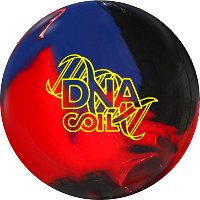Coupon excludes instant bonus items, hot deal items, and gift certificates.
Axis Tilt and Axis Rotation
Axis Tilt and Axis Rotation
By Bowling.com
Many bowlers confuse axis tilt with axis rotation. Axis rotation is determined by the amount of side roll that your hand applies to the ball. Axis tilt is the spin that you put on the ball. Tilt increases as the circumference of the ball track lessens, there's more tilt with a spinner and less tilt with a high track.
To determine the tilt of your axis, you must find the axis of the ball's rotation. Throw a few balls on the oiliest part of the lane so you have an oil track all the way around the ball. Take a grease pencil and trace that oil track all the way around the ball. You want to use the track that is the closest to the finger and thumb holes. That's your track for the initial rotation of the ball on the lane (most of today's ball flare finds the track and axis changing as the ball rolls down the lane).
Once you have marked the initial rotation/track of the ball, place the ball on a ball cup, on a table. Rotate the ball until the track is horizontal to the table. Now take a flexible measuring tape and measure the distance from the track on one side of the ball over the top to the track on the other side of the ball. Use a grease pencil to mark the point on the top of the ball that is half the distance from the two sides of the track. Now rotate the ball a quarter-turn while keeping the track horizontal, and repeat the measuring process. Mark the point that these two lines intersect with a piece of tape or a round dot. This is the axis point of your ball's rotation.
The tilt of the axis is determined by the track of the ball. If the track of the ball covers 27 inches, which is the full circumference of the ball, there would be no tilt. This type of roll is normally a complete straight ball that rolls right over the middle of the finger holes and thumb hole. A semi-roller track covers less of the circumference of the ball and will have some tilt. The spinner track will have the most tilt.
If the track covers the full circumference of the ball and has zero degrees tilt, how do we determine how much tilt the other tracks have? The easiest way to measure the tilt of the axis is by, again, marking the first track around the ball. Find your axis point and mark it. Next, put the ball on a ball cup, on a table and rotate the ball so the bottom of the track is in the middle of the bottom of the ball on the table. Then rotate the ball until the track is facing you, so you can see the bottom and top of the track in front of you. Then mark a line around the ball that is right in the middle of the ball. From this line, you can measure the distance from the line to the axis to see how far the axis is from the center of the ball. Every 1 1/8 inches the axis tracer is above the center line represents 15 degrees of tilt.
How does this help your game knowing your Axis tilt and rotation? Depending on what type of pattern you are bowling on, spinners get natural length and require earlier rolling(dull or solid) equipment at times. Where as the semi-roller has a lower axis rotation which causes equipment to read early and this requires them to purchase Pearlized equipment. Again depending on the pattern you are bowling on will also require certain types of reactions.
High Axis Rotation gets more length and backend naturally. Low Axis Rotation creates an early and even roll. Know and understand your game to take it to the next level. Remember to enjoy the game of bowling and as always Practice Practice Practice!
Steve Lemke Bowling.com SFA NCAA Coach













